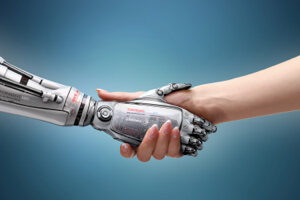 One of the most transformative discussions I’ve recently taken part in during a meeting of innovation leaders in New York was around what will work look like in the future. Like the industries themselves, work within those industries is undergoing radical disruption as well. Most of it is driven by the capabilities of Third Platform technologies (IoT, NLP, AI, Augmented Reality, Robotic Process Automation, etc.), enabling mobility, increasing efficiency and enabling new modes of interaction, collaboration and engagement with the workforce.
One of the most transformative discussions I’ve recently taken part in during a meeting of innovation leaders in New York was around what will work look like in the future. Like the industries themselves, work within those industries is undergoing radical disruption as well. Most of it is driven by the capabilities of Third Platform technologies (IoT, NLP, AI, Augmented Reality, Robotic Process Automation, etc.), enabling mobility, increasing efficiency and enabling new modes of interaction, collaboration and engagement with the workforce.
The term “Intelligent Enterprise” is increasingly being used to describe companies which effectively harness these new capabilities.
Within this transformation the human element is likely to be the most impacted from both a workplace organization standpoint as well as the socio-economic consequences it will produce. Already the cradle-to-grave employer attachment model is disintegrating. The skilled workforce is gravitating to increasingly fluid attachments to specific engagements, projects, professional development opportunities – much more so than to the employer itself. The natural progression, as many forecast, will be a completely fluid model of work, where the relationship between a producer (employer) and the workforce will be primarily task-oriented.
In a task-based economy, those with in-demand skills are sought after by multiple producers and engage in multiple relationships concurrently. Rewards are more directly tied to production (be it goods, services or intellectual capital) and, supported by n-fold efficiencies afforded by the Third Platform, fewer workers are directly involved in production.
From this point discussions usually diverge into socio-economic considerations of such dramatic changes. After all, in the past, such core-value changes have led to massive economic upheaval, even wars. Can a more concentrated and efficient economy support the sustenance and emotional needs of society? How are essential services like healthcare (and their associated costs) managed ? How do our cities transform when they are no longer the hubs of employment?
Some in these discussions reference the adage that, relative to the industry of the mid 19th and 20th centuries, where 90% of workforce was engaged in agriculture, today we are all the equivalent of unemployed farmers; that with each industrial revolution, society adapts to find its new equilibrium and it will do so again this time.
Companies are not just participating in these discussions, but they are actively working on workforce transformation programs to adapt to the anticipated new reality.
Are you personally working on preparing yourself for this transformation ?